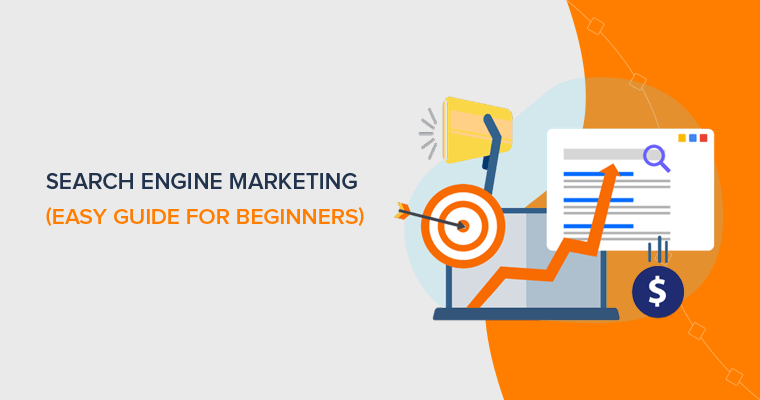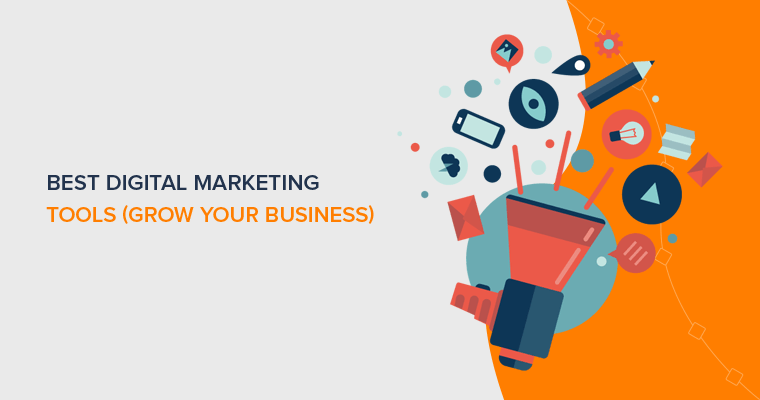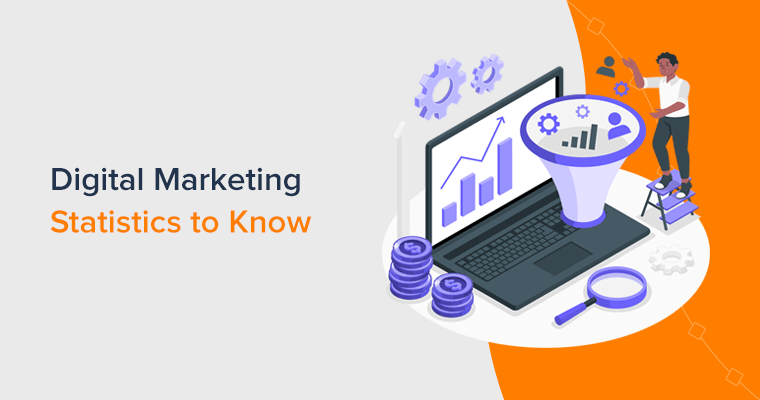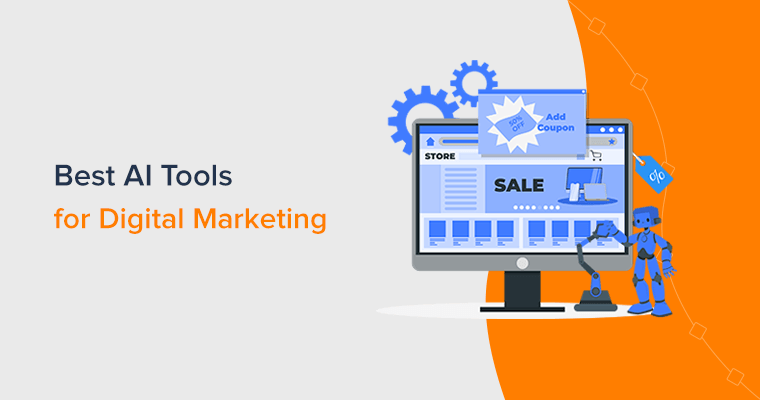Do you want to know “what is Search Engine Marketing (SEM)?” Then, here you are! You’ve found the best guide on SEM.
Search Engine Marketing (SEM) is a popular digital marketing strategy useful to achieve good traffic flow to your site from search engines. It’s marketing your business via search engine advertisements. So, it’s a quick and easy way to gain more audience and get ahead of your competitors.
So, we’re here with the complete guide on search engine marketing (SEM) especially ideal for beginners. After completing this guide, you’ll have the overall knowledge of SEM, its aspects, and some proven ways to apply successful search engine marketing strategies.
So, let’s begin.
A. What is Search Engine Marketing (SEM)? – Overview
In simple words, Search Engine Marketing (SEM) is the process of marketing your business via paid advertisements on search engines like Google, Bing, Yahoo, etc. It helps your site appear above the free results on search engines when users enter certain keywords.
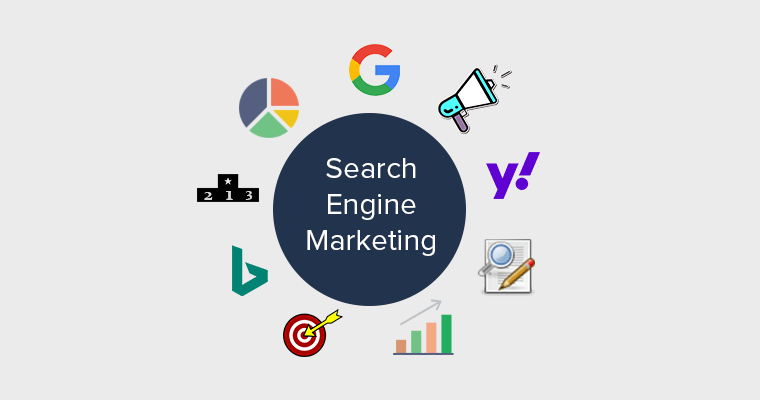
In other words, SEM makes your web page, products, or services visible in search engine result pages (SERPs). So, your website or blog is likely to get more visitors from search engines. More users mean more business, which ultimately helps you earn more profit from your business.
The idea is to display your ads in the search result pages whenever people search for certain queries in the search engines. It means that you can run ad campaigns targeting certain keywords. And, whenever people search for those terms, your ad comes up on the search engine result pages (SERPs).
Now, you might have seen SEM paid ads on search engine result pages during searches. If you haven’t noticed yet, then how to tell if a given search result is a paid advertisement? Let’s see that from the example below.
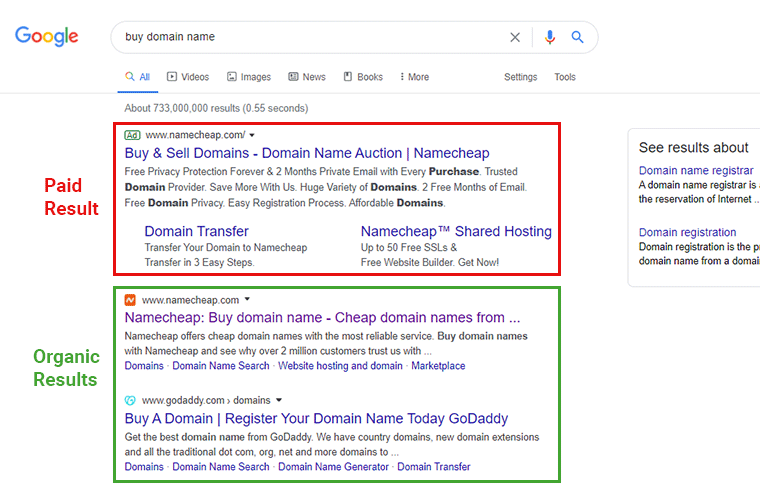
Here, we have a search term ‘buy domain name‘ for which there are various search results. Now, you can see that the very first result has the label ‘Ad‘ on it. It shows that this one is a paid result. It’s an example of SEM. And, the others are organic results.
How Many Paid Results Appear on Search Results?
In the above example, there’s only one paid result. However, there can be a listing of multiple paid results for the same search terms at different times.
It’s simply because multiple brands and companies could run search engine marketing campaigns for similar keywords. And, among the paid results too, search engines have different strategies for determining the number of results and their ranks. And, we’ll also be talking about the ranking process of paid results below.
It’s seen that the paid results always exceed the rankings of organic results. In most cases, it’s true. However, there’re cases where your paid result may appear below organic results.
B. Top 3 SEM Platforms to Start Marketing
Search Engine Marketing (SEM) platforms are specific tools offered by search engines to allow marketers to run and manage paid ad campaigns. They let you create ads, allocate budget, select campaign type, choose keywords, analyze, and other preferences.
There’re different SEM platforms that you can use to run your ad campaigns. Most of them are created by the search engines themselves. For example, Google Ads is created by Google. Similarly, Microsoft Advertising is created by Microsoft (the owner of Bing).
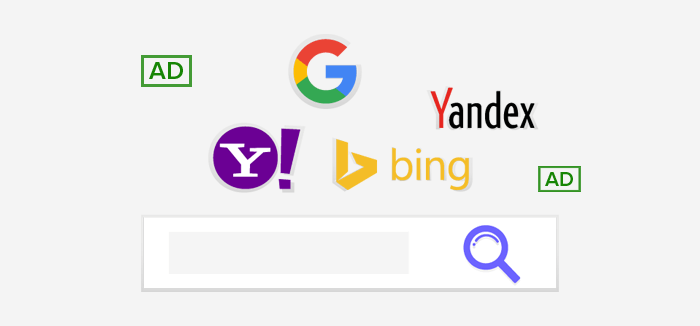
Normally, the platforms display ads on their own native search engines. Whereas some platforms manage ads on other search engines too. For example, Microsoft Advertising manages ads on DuckDuckGo, Google Ads on Ask.com, etc.
Also, the ad platforms provide other tools to help you optimize your ads. Example: Google Keyword Planner is a tool to help you find appropriate keywords for Google Ads.
All SEM platforms operate on mainly PPC (pay-per-click) marketing strategy. It means that you’ll only have to pay if someone clicks on your ads. However, the CPC (Cost Per Click) amount may vary on different platforms. It’s the cost that an advertiser has to pay per click on your ad. We’ll talk about it more later.
Now, here are some of the popular SEM platforms.
1. Google Ads
Google Ads (formerly known as Google AdWords) is the SEM platform that helps you advertise on Google search engine. It’s the most popular platform compared to others. It’s popular for the obvious reason that it manages ads on Google, the most popular search engine.
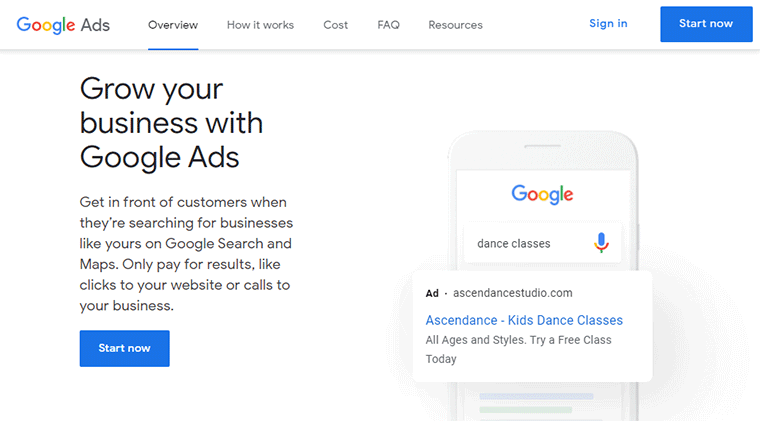
To get started with Google Ads, you just need to have a Google account. Then, you can just sign up for Google Ads and start building your campaign right away. You can choose a location, keywords for finding more potential customers. Similarly, it offers you a flexible budget limit, time, and ability to pause/resume your ad at any time.
2. Microsoft Advertising (Bing Ads)
Microsoft Advertising (previously called Bing Ads) is an advertisement platform offered by Microsoft. It’s specifically used for running ad campaigns on Bing. However, once you sign up and run an ad campaign on Bing, the ads will display on DuckDuckGo too.
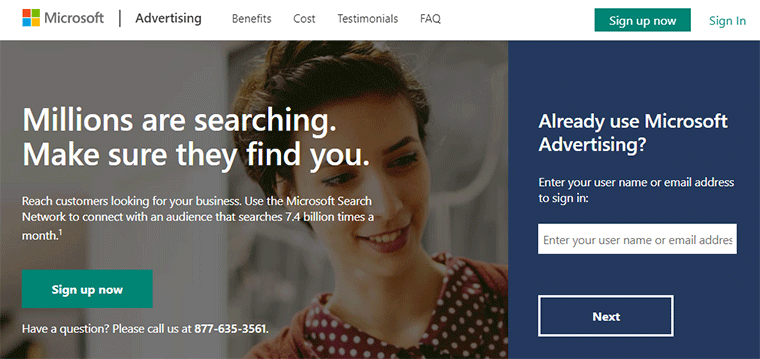
With Bing Ads, you can choose to display or restrict ads according to devices, locations, and time zones too. Also, you can bid on particular keywords to have the highest ad rank on those keywords. It has a low CPC as compared to Google Ads.
3. Verizon Media Native (Yahoo! Gemini)
Verizon Media Native (Yahoo! Gemini previously) is a company for search engine advertisements. It’s owned by Verizon media, which is also the owner of Yahoo!. This advertisement company handles search ads mainly for Yahoo! and AOL.
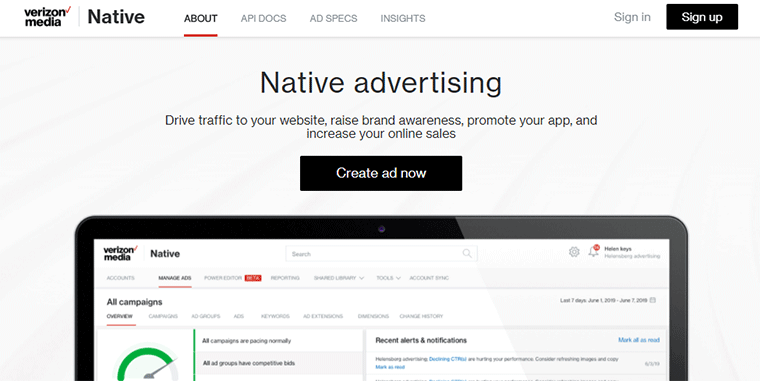
It’s also a popular service for native advertising. It’s the type of advertising in which the ads match the platform that it appears on.
C. SEM vs. SEO – What’s the Difference?
You might’ve got some idea on SEM till now, that it’s the way of paid marketing with search engines. Similarly, Search Engine Optimization (SEO) is also a strategy for marketing your business or website with search engines.
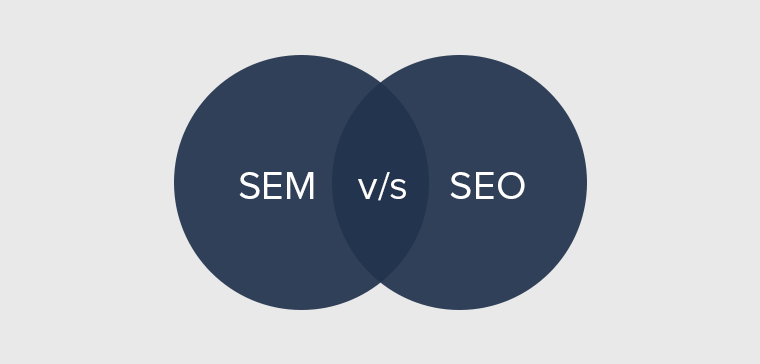
But unlike SEM, SEO focuses on gaining free or organic traffic without paying to get a spot on search engines. Rather, SEO focuses on optimizing websites so that they become eligible to be ranked higher in search engines.
So, you see both the techniques have applied search engine promotion for gaining traffic. Moreover, both marketing strategies focus on displaying results relevant to the search keyword.
Now, here’re some of the differences between SEO and SEM based on various factors.
i) Cost
Now, the first and foremost difference between SEO and SEM is the cost of these campaigns. SEM works on displaying paid results for a specific keyword in search engines which obviously requires you to pay. Whereas SEO focuses on gaining the search engine rank without paying, but by optimizing your site for relevant keywords and better user experience.
ii) Time
Likewise, SEM gives results faster in comparison to SEO. With SEM, you can place your paid result immediately in just a few steps. You can start running paid ad campaigns any time you like which will start to show the results on SERPs shortly after you start the campaign. Thus, you can start to generate income very soon.
Whereas, SEO doesn’t happen overnight. It requires a longer period of time to compete with other sites and gain ranks based on the quality it provides to the users. Various things like site speed, security, content quality, ease of use, users’ trust, credibility, etc. come into consideration while maintaining SEO.
iii) Position
We’ve already mentioned above that SEM results are placed before organic results on the SERPs. With that, your SEM effort gets you ahead of your competitors. So, your brand will have good exposure. Also, you’ll have a good number of visitors flow to your site and sell more.
iv) Ranking Duration
Another difference, SEO is a long-term strategy compared to SEM. SEO strategies help your web page get a lasting position in a search engine. The pages’ spot might go up and down at times, which you can work on improving. But, web pages once optimized for SEO remain on higher rank for a longer time. And thus, your web pages ranked with SEO provide value over time.
In the case of SEM, your results only appear in the SERPs as long as you wish to pay for your campaign. Also, you can choose to remove the ad at any time you want.
Anyway, both SEM and SEO are important strategies for your online marketing efforts. So, we recommend you do a thorough reading on ‘What is Search Engine Optimization (SEO)?’ with our detailed guide. It helps you learn the basics of SEO, how it works, and some proven SEO techniques.
D. How SEM Works – Understanding PPC
Pay-Per-Click (PPC) is a marketing strategy where you’re charged every time your ads get clicks. Moreover, you’re only subject to pay when someone clicks your ad. Hence, the name, Pay-Per-Click.

PPC is associated with search engine marketing. So, let’s talk about it here.
Basically, SEM platforms like Google Ads, Microsoft Advertising, and other search advertisers have adopted the use of the PPC model for payment.
However, SEM also allows other ways of payments like payment based on impression, conversion, etc. But, PPC is the most popular and the best one. There are only rare cases when advertisers use methods other than PPC.
PPC payment strategies are not only limited to search engines. Social media like Facebook, Instagram, etc have started using PPC as one of their advertising strategies.
Anyway, PPC is the most popular way of advertising on search engines. That’s the reason why people refer to SEM as PPC marketing. Also, these two terms are seen used interchangeably.
If PPC strategy is used for advertisements other than searches, then you can’t refer to it as SEM. Otherwise, PPC normally means SEM.
E. Benefits of Search Engine Marketing (SEM)
Let’s see the benefits that search engine marketing offers.
1) Instant Reach & Results
With SEM campaigns, you can reach your target customers instantly. As soon as you start the campaign, your ad starts displaying in search engine result pages for your target keyword. And, they’ll also bring instant growth as the result.

With that, you can showcase your products and services as ads and earn revenue from them within a short time.
2) Brand Awareness
With SEM, you can display your brand’s name and services with your ads on search engines. So, you can aware people of your brand and the services your brand provides. Also, your ad gets placed at the top of the result page so it gets more attention compared to others.
Now, with people noticing your brand, they become more familiar with the name next time they see it. And, they could even use your services.
3) Low Cost
The best thing about SEM is its model of payment i.e. PPC. We’ve already mentioned above, as a brand, you’ll have to only pay the amount as per the clicks it gets. Meaning, it doesn’t even cost you just for running the PPC campaign.
Remember that the cost that you’ll have to pay for the campaign may vary. It really depends on the campaign type, competition, keyword difficulty, and the amount you’re willing to bid per ad click.
4) Target Audience with Buying Intent
In traditional marketing (e.g. ads on TV, radio, etc), the ads are broadcasted to all types of people randomly without targeting. Or, some strategies (e.g. email marketing) let you target a relevant group of audiences, but you can’t tell if they’re likely to buy from you.
However, with SEM, you can capture visitors with more buying intentions, unlike any other marketing approach. And then, you can convert the visitors into customers.

It’s because SEM marketing is purely based on target keywords. So, your ads will display only to people who search for certain keywords that you’ve selected as your target keyword.
For example, if you’re a company selling computer accessories, then you can run your ad on keywords like ‘cheap computer accessories‘. So, it’ll display only to the people who search the term. People search for those types of keywords generally with the purpose of buying.
5) Target Location-Based Audience
Various SEM platforms like Google Adwords allow targeting audiences based on geographic location. You can choose to display your ads in a certain area like countries, regions, or even a small area.

Location targeting is important for small businesses to gain local customers within a certain area. That way, you can advertise to more specific visitors and potential customers.
Also, it offers you excluding ads in certain locations. So, you can use this feature to exclude displaying ads from places where you’re unlikely to find customers.
6) Remarketing/Retargeting
Remarketing/Retargeting is the practice of advertising to users who’ve already visited your website and left without using your services.
Retargeting helps you display your ads to the same users on different sites, apps, or Google searches. That way, you can convert the abandoned users into paying customers. Also, this is a proven way of increasing the conversion rate and ROI (Return on Investment).
7) Season Based Campaigns
You can start and stop your ad campaign any time you like. It’s one of the major features of SEM.
With that, you can run your ad campaigns at appropriate times for growing your business. For example, you can create and run ad campaigns for selling products during festivals. Or, sports shops can advertise jersey kits during the start of leagues and game seasons.
F. SEM Keywords (Choosing the Right Keywords)
SEM keywords are the terms or a combination of words for which you want your ads to appear on the search engine results. Keywords are among the most important aspects of search engine marketing.

In SEM, you target a keyword that users are most likely to search on search engines. And, your ads will be displayed when someone types similar search queries. Search engine marketing platforms like Google Ads let you enter your preferred keyword during the creation of ads.
Choosing the right keywords for your sponsored ad campaigns makes your business the most profitable.
So, what’s the right keyword for your ad?
Choosing keywords is a decision that you’ll have to make after thinking thoroughly. So, here’re some of the things to remember while choosing keywords.
a) Keyword Relevancy
The most important thing, of course, you should choose a relevant keyword. That is to say, the keyword you pick should focus on describing the products and services you provide. So, you’ll be visible to the visitors when people search for relevant queries as your business.
Suppose, you want users to sign up for a webinar you’re conducting on marketing. Then, you can run an ad using a relevant keyword like ‘Free Webinar on Marketing‘. People who actually want to attend the webinar might search for the same terms for which your ad will appear.

If your ad would be displayed on some other random keywords, then it’s less likely to convert.
b) Search Volume
Along with relevancy, you should also check the keywords’ search volume (the number of monthly searches on a specific keyword). It’s because if your target keyword has a low search volume, then it’ll get fewer visitors.
For example, you’re creating an ad to drive traffic on your website selling WordPress themes. Then, you might bid on some relevant keywords like ‘best WordPress templates‘. But, if a similar keyword like ‘best WordPress themes‘ has a larger search volume, then you might want to create an ad targeting this keyword instead.

For checking the search volumes, you can take help from various digital marketing and keyword tools. Search engines like Google and Bing offer you researching keywords on their own platform. Moreover, you can use other tools like SEMRush, Ahrefs, Long Tail Pro, etc.
c) Competition
Here’s a fact! The keywords with the most relevance and high search volume have the most competition. It means that other brands can also have ad campaigns on the same keywords. So, it might affect your ad ranking.
With high competition, the cost of their bidding also comes to be high. So, if you’re a small business, then you might not keep up with the big brands running with bigger budgets.
For that case, you can run ads on more specific keywords, also known as long-tail keywords. For example, you’re an interior designing company based in let’s say, New York. Then, you can choose keywords like ‘Interior Designer in New York‘ rather than just ‘Interior Designer‘.

Here, the keyword ‘Interior Designer in New York’ is a long-tail keyword that targets customers for a specific service in a certain location.
Long-tail keywords might have a lesser search volume. But, you’ll get a spot on search engines when people specifically search for that keyword.
So, a good idea of selecting a keyword would be balancing between keyword relevancy, search volume, and keyword competition.
G. How to Keyword Research for SEM?
Basically, keyword research is the process of finding out keywords you must target in your search engine ads. To be more precise, it’s the act of choosing keyphrases that convert best for your business. Or more simply, it’s about knowing what keywords users type into search engines to search businesses like yours.

Researching keywords let you know the keywords most relevant for your ad. Also, you can know what’s the search volume and competition on those keywords. That makes it easier to plan your keywords better.
It’s not only about using and fully relying on the tools and technologies for finding the best keywords. But, it involves using your sense to understand your potential customers. You should think critically about what the users would enter into the search box so that your ad would reach them.
Here’re the things you can do for a start.
01. Create Initial Keyword List
You can start your keyword by preparing an initial list of keywords from your ad copy. Go through the web page/landing page that your ad redirects to. Then, list out a handful of keywords.
Make sure that you focus on choosing the most relevant keywords for this list. Go for your brand-related terms, and keywords that describe your business.
Also, you should focus on specific keywords (long-tail keywords) instead of a general term indicating your business.
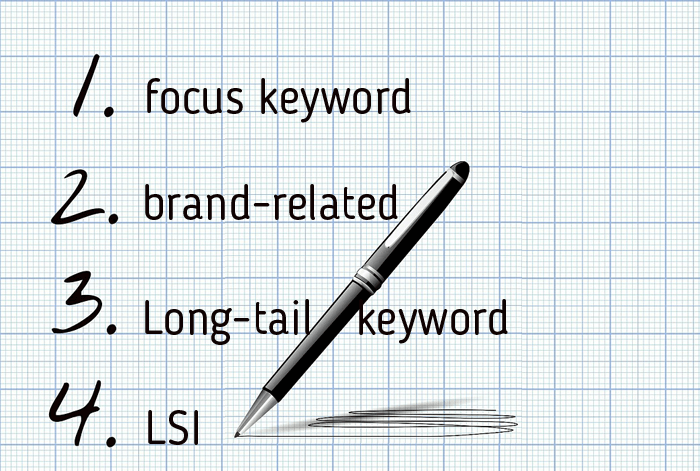
Furthermore, you can use synonyms or other variations of the keywords if you want. So, you can have a larger list of all possible keywords.
02. Use Keyword Research Tools
You can take the help of keyword research tools to expand your list. Also, you can use it for refining your keywords by eliminating some. As already mentioned the most popular keyword research tools are:
- Google Keyword Planner
- Microsoft Keyword Planner Tool
- SEMRush
- Ahrefs
- Long Tail Pro, etc.
The keyword research tools let you enter the keyword about your business or service. Then, it comes up with keyword suggestions which you can use. You can include those suggested keywords on your list.
Meanwhile, you can also use the tools to check the search volume, competition, and CPC (Cost Per Click) for each keyword on your list. Then, you can eliminate the keywords with high competition and CPC.
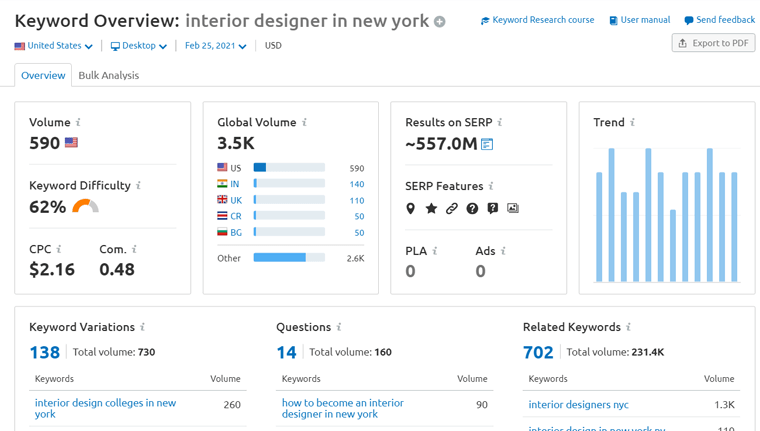
Keywords that have a high search volume and low competition are the most desirable ones.
03. Create Ad Group
Creating an ad group is an important step in your keyword research efforts. An ad group is a list that consists of closely related keywords.
Actually, an ad group is a feature that SEM platforms offer. The feature allows you to create a group containing a list of keywords for which you want to display your campaign ad.
It means that you add the relevant keywords in the ad group that people are most likely to search for. And, your ad would be relevant to their search.
For example, if you want to promote your coffee shop in your location, then your ad group can contain keywords like
- best coffee place
- café near me
- good coffee nearby
- nearest coffee place, etc.
You can use the keywords you’ve collected and refined with SEM tools from earlier.
04. Assign Match Types
Now, while entering the keywords in the ad groups, you can also assign a match type to each target keyword. Specifying the match type of keywords lets you control how strictly you want the users’ search query to match your keyword for displaying your ads.
There are especially 3 types of keyword matches.
- Broad Match Keyword – Users’ search query containing any combination or part of a broad match keyword of your campaign will display your ad. For example, if someone searches with the keywords ‘coding academy’, then they’re likely to see an ad for ‘online coding classes’.
- Phrase Match Keyword – Your ad will display if the search query exactly matches a phrase match keyword. However, the search term can have other words before or after the phrase match keyword.
- Exact Match Keyword – When you use the exact match keyword, your ad will display only when the users’ search term matches the keyword you’re targeting.
Note:
When you add a keyword in ad groups, it’s a broad match keyword by default. Example: A keyword
If you write the keywords inside quotation marks, then it becomes a phrase match keyword. Example: “A keyword”
And, to add an exact match keyword, write it inside brackets. Example: [A keyword]
05. Add Negative Keyword
A negative keyword is a keyword that you don’t want to include in your campaign. These are the keywords for which you don’t want to display your ad.
Negative keywords might somehow be related to your target keywords, but not relevant to your business. Moreover, your ad could come across users with different search intent. So primarily, a negative keyword avoids your ads to display on irrelevant searches.
For example, if your business is selling smartphones, then your ads displaying on the search phrase ‘repairing smartphones’ is useless. So, you can add that term as a negative keyword.
Similarly, other common negative keywords can be ‘free’, ‘free trial’, ‘coupons’, etc.
H. SEM Ad Position and Ad Auction
You might have seen more than one ad appearing in search engines. In Google, up to 4 paid ads can appear for a single keyword. Those ads are run by individual brands providing similar services to customers with a similar target keyword.
The ad which gets a higher position on a search result page is likely to get more clicks. Thus, you’ll have a chance to sell more. So, every company wants their ad to get the first spot in search results.

However, if many ad campaigns are running for similar target keywords, then there’s high competition. And, your ad might not even show up on the search engine result page, if not optimized properly.
Now, a question might arise about how the ads get a spot on search results? Also, what position does your ad achieve?
Among amateur marketers and beginners, there’s a general belief that the ad with the highest budget always secures the first position. Of course, having a good budget boosts your ads to a certain extent. But, there’re more factors that make a successful search marketing campaign.
Now, search engines select the ads appearing in search results based on a process called ad auction. We’ll explain that in the following sections below.
What is Ad Auction & How it Works?
Ad auction the process that determines if your ad is eligible to appear on SERPs. It also decides what position your ad will achieve.
The ad auction process is triggered when someone enters a search query. If the users’ search intent matches any target keyword in your ad group, then your ad will enter the auction. Then, the search engines check mainly 2 parameters of your ad. They are:
- Maximum Bid
- Quality Score
1. Maximum Bid
The maximum bid, also called max CPC (Cost Per Click), is the highest amount you’re willing to pay when someone clicks your ad. You’re allowed to set your maximum bid amount when creating your ad campaign on SEM platforms.
The keyword research tools also provide information on keywords’ maximum bids based on the analysis of previous campaigns. So, you can use the tools to check the max CPC for all individual keywords on your ad group.
You can set the maximum bid by aggregating keywords’ maximum CPC. Or, you can also set the maximum CPC based on an individual keyword. It’s up to you.
2. Quality Score
The quality score is a parameter that gives the overall quality of your ad. Various things come into account for determining the quality score of ads. It focuses on your ad organization, users’ experience on your landing page, historical performance, etc. to evaluate the quality score.
Your SEM platform itself calculates the quality score of your target keyword based on those factors. And, the score ranges from 1 to 10, 10 being the best score.
There’re primarily 3 things that determine the quality score of your ad. They are
- CTR (Click Through Rate) – It’s the number of predicted clicks your ad could get when it appears on search results. Search engines predict the expected CTR based on the historical data of the keywords used in your ad.
- Relevance – Search engines check the match of the search term with the phrase on your ad heading and description. More relevant ads increase the quality score.
- Landing page experience – Having a relevant landing page that matches the users’ search intent can increase users’ landing page experience. Also, it tells how easily the visitors can use the services linked on the ads landing page.
What is Ad Rank & How It’s Calculated?
Now, search engines use these 2 metrics: maximum bid and quality score to calculate the new metric called ad rank.
Ad Rank is the score of your ad that determines where your ad will be placed in comparison to the competitors. The mathematical formula for calculating Ad rank is:
Ad Rank = Maximum Bid × Quality Score
The ads in a search result will appear in the order of their individual Ad Rank score.
This also shows the importance of the quality score of your ad as it’s the half portion that your ad rank depends on. So, you can focus on improving your ads’ quality score. Importantly, it helps your ad achieve a higher spot at a lesser cost.
Now, let’s understand ad rank with an example.
Say 3 ads A, B, and C are competing against one another. The maximum bid of ads A, B, and C are $2, $3, and $3.5 respectively with their quality scores 8, 7, and 4.
So, the Ad Rank score of A = 2 × 8 = 16
Similarly, Ad Rank score of B = 3 × 7 = 21
Lastly, the Ad Rank score of C = 3.5 × 4 = 14
Since ad B has the highest value for Ad rank, it’ll get the first position. Similarly, ads A and C will get the second and third positions respectively.
This example also makes it clear that only a higher budget won’t win you the highest spot on the search engine’s paid results. Meaning, you should also have a good quality score.
So, rather than just spending more on your ad budget, you should focus on increasing the ads’ quality score. To do so, you can optimize your landing pages, write attractive headers and descriptions, etc.
What’s your Actual Cost Per Click (CPC)?
So, do you actually have to pay your maximum bid amount for clicks the ads receive? The answer is no!

You’ll just have to pay the amount just enough to outrank the ad below your position. Suppose, your ad is in the second position. Then, your CPC would be the amount that makes your ad rank score just a little higher than the ad in the third position.
However, the last ad on the paid search result list would have to pay the highest bid amount.
Now, from the above example, let’s find out how much ads A, B, and C would pay.
Ad C would pay its highest bid amount i.e. $3.5 since it’s the last one in the order. Its ad rank value is 14.
Now, to outrank ad C (ad rank = 14), ad A should have an ad rank a little higher than 14. Just for demonstration, let’s say you should have an ad rank score of 14.05.
Now, let’s calculate it. Ad quality score of A = 8. Required ad rank score = 14.05. So, CPC for A is: 14.05 / 8 = 1.756.
So, the CPC for Ad A would be $1.76.
Similarly, ad A has an ad rank value of 16. To outrank that, ad B should have at least an ad rank value of 16.05. And, its quality score is 7. Then, its CPC would be 16.05 / 7 = 2.29.
So, the CPC for ad B would be $2.29.
Clearly, you won’t have to pay the highest bid amount but just the amount enough to beat the ad rank of the ad below yours.
Where can your ad appear in a Search Engine Result Page (SERP)?
It’s a less known fact that paid ads could also appear below the organic results at the bottom of the page. It’s because people generally think that paid text ads always appear on top of the result page above the organic results.
Take this Google search for example in which an ad is appearing beneath organic results.
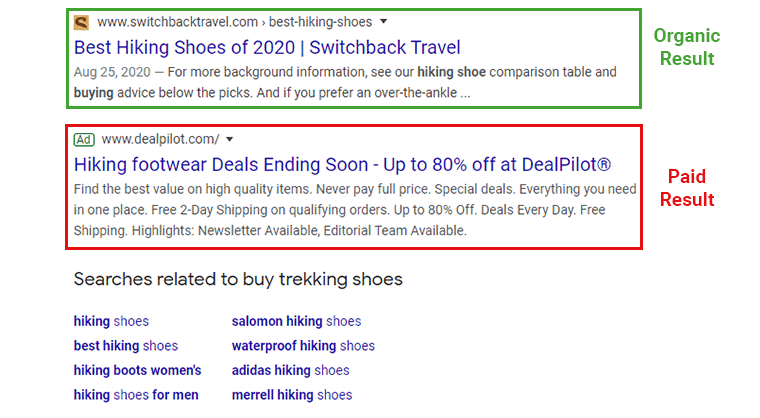
As for Google, it uses an algorithm for determining the ads’ position. It has set minimum ad rank values for:
- For displaying on the result page.
- For displaying ads above organic results.
Google sets the minimum ad rank value dynamically for each search and the value differs in each search.
Now, your ad’s rank value has to exceed both these values to appear at the top of the result page over organic results.
If it only exceeds the minimum value for displaying on the result page, then it’ll be placed below organic results.
If your ad’s ad rank doesn’t meet the minimum value for displaying on the result page, then it’ll be discarded out.
Let’s see an example.
Suppose that the minimum ad rank for displaying on the result page is 10. And, the minimum ad rank value to display above the organic list is 50.
Then, any ad with an ad rank value of more than 10 would appear in the result. And, if the rank exceeds 50, then it’ll display above the organic results. If the ad rank value is below 10, then it’ll not appear anywhere on the result page.
With that said, now let’s go ahead and see an actual example of how to create a Search Engine Marketing (SEM) strategy with Google Ads. Let’s begin!
I. How to do SEM Properly (Using Google Ads)
Now, you might want to learn how to carry out search engine marketing properly. Here, we’re demonstrating the stepwise process of creating an ad campaign with Google Ads.
For demonstration, we’ll be creating an ad for promoting men’s fashion sunglasses in Atlanta.
But before that, you should create a complete website for your business. And, most importantly it should have a well-designed landing page. The landing page is where your audience will land after clicking on the ad link. Make sure it has plenty of call-to-action elements, cool design.
Let’s start.
Step 1: Sign Up to Google Ads
To start with Google Ads, you need to have a Google account first. So, you should create your Google account first if you already don’t have one.
First, go to your web browser and enter the URL ‘ads.google.com’. Then, click on ‘Start now’.
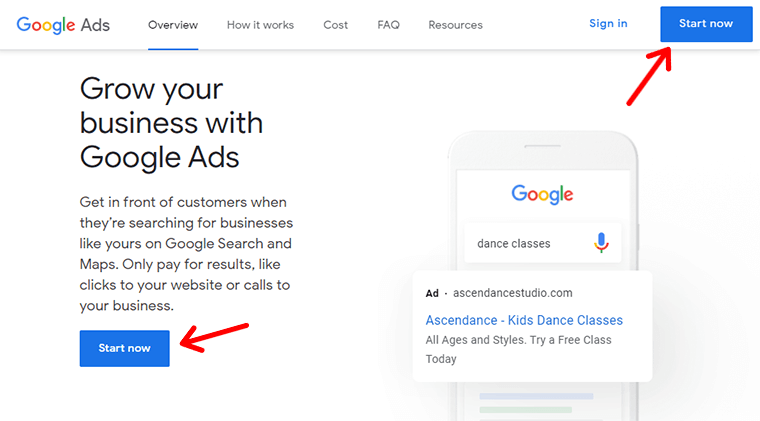
After that, sign in with your Google account and password.

Then, click on ‘New Google Ads Account’.
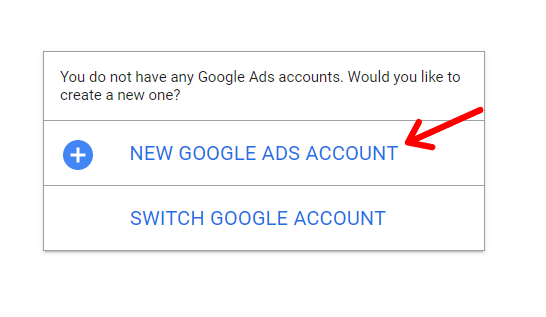
Step 2: Create Campaign
After that, it asks you to select your advertising main goal. But, you can just skip that and click on ‘Switch to Expert Mode’. That provides more ease in creating campaigns.
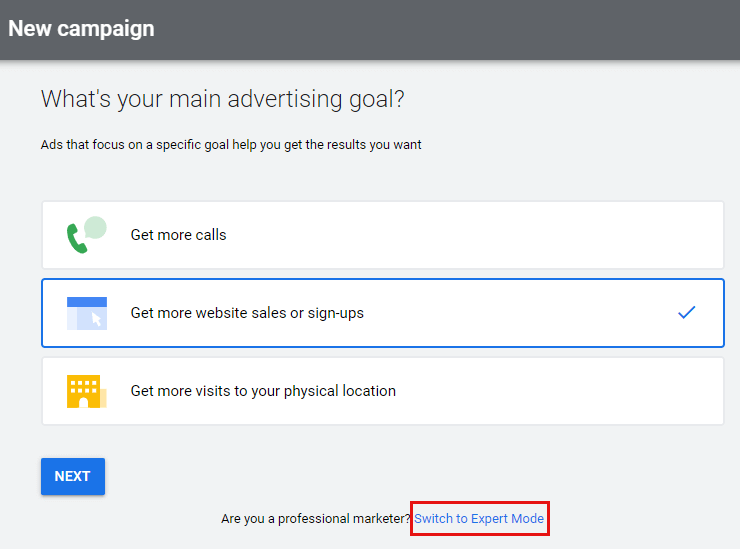
On the next page, you’ll have to provide some information. First, select your campaign goal ‘Website traffic’. And then, select campaign type ‘Search’. Then click on ‘Continue’.
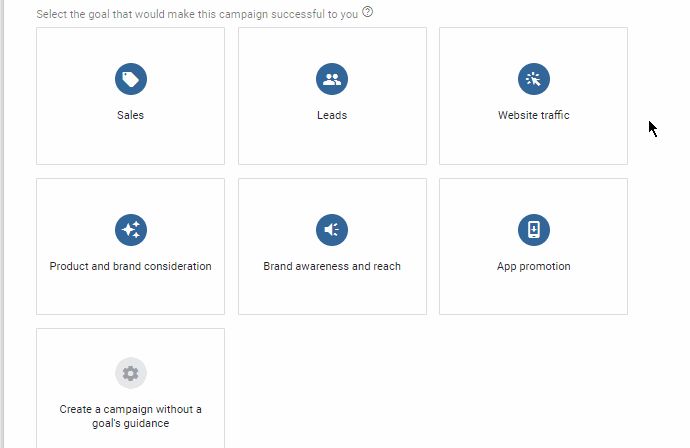
Step 3: Campaign Settings
On the next page, you’ll need to manage campaign settings. Start by giving your campaign a suitable name. In Networks, untick both Search Network and Display Network. They’re not important for displaying text-based ads on Google.
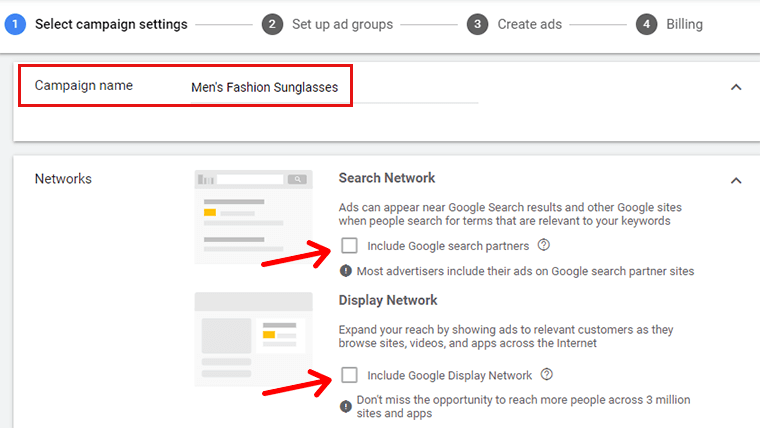
After that, enter your custom target location by clicking on ‘Enter another location’.
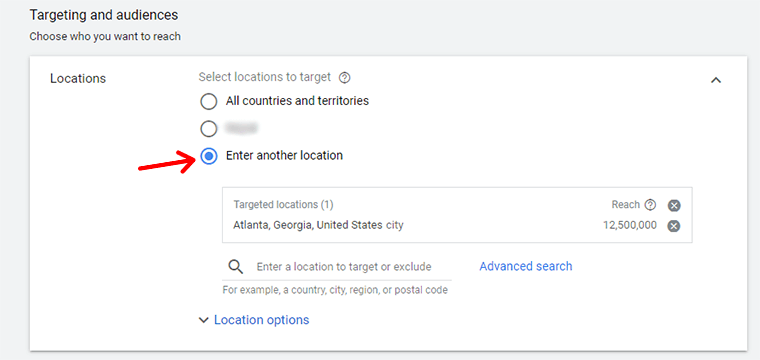
Then below, you’ll come across the ‘Budget and bidding’ section. First, enter the amount you want to spend per day. Typically, $5 to $10 is good for starting.
Then, tick on ‘set the maximum cost per click bid limit’ and enter your max CPC bid. The keywords you use for the ad determines your maximum CPC better. You can just enter $1 for now, which you can also change later by better analysis.
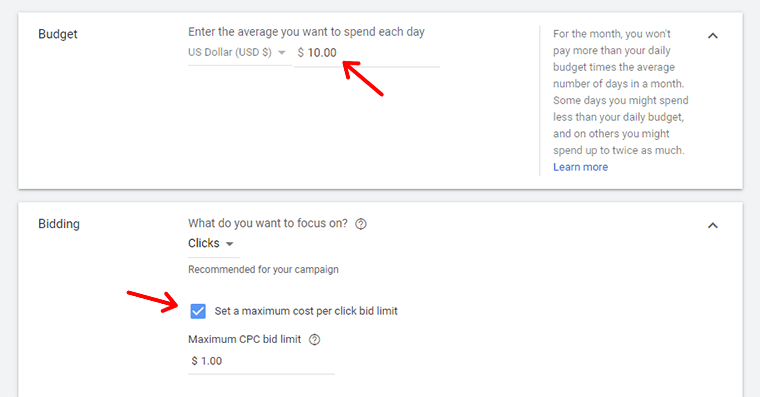
You can also check other settings in this section if you like. You can find settings like ads start date, end date, schedule, targeting options, extensions, etc. However, you can also work on these settings later if you want.
After that’s done, you can just click on the ‘Save and Continue’ button that you see at the end of the page.
Step 4: Set Up Ad Groups
This step is for selecting the keywords and adding them to an ad group. These keywords determine if your ad reaches your target customers. So, it’s better to do good keyword research first.
For that, you could take help from the Google Keyword Planner, the tool provided by Google itself. But, you can’t use it until you’ve completed creating your first ad campaign. So for now, you can just enter some keywords that you think fits best.
First, give your ad group a name. Then, enter some keywords that you think people would search in Google to find services like yours. We recommend you enter at least 5 keywords. And, don’t forget to assign appropriate match types.
After that, click on Save and Continue.
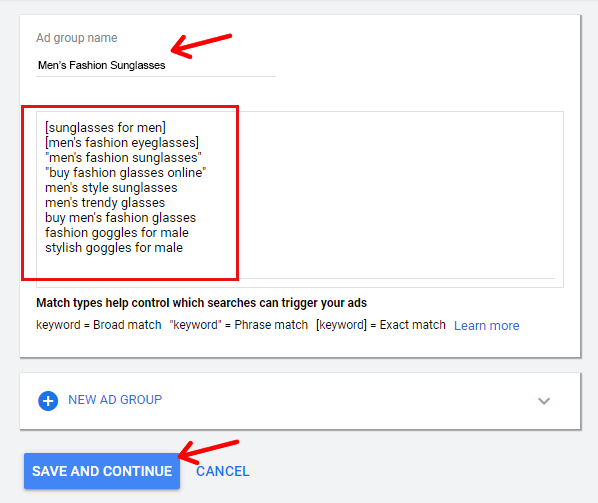
Step 5: Create Ads
The next step is creating an ad copy. Here, you’ll have to write the most attractive headlines, descriptions, and URLs.
First, enter the URL of your landing page i.e. the page that you want your visitors to reach when they click on your ad.
After that, write appropriate headlines for your ad. You can enter up to 3 headers. So, use them wisely that your ad would look attractive. Be sure that it’s not very long but has a fair length. It’s important that no characters are hidden when your ad comes up in Google. You can check it on the screen simultaneously while creating an ad.
After that, you can enter the description. You can write 2 descriptions, both up to 90 characters.
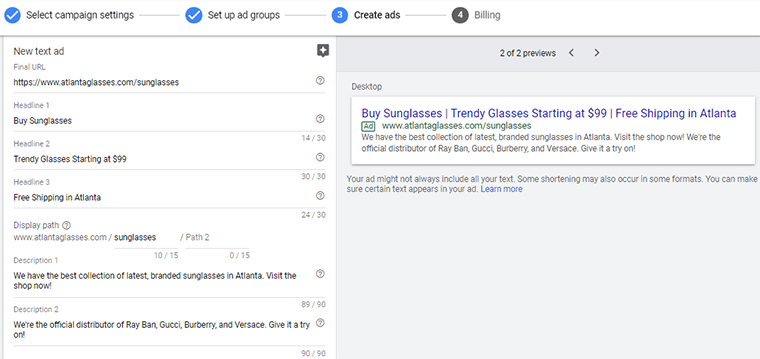
After done, click on ‘Save and Continue’.
Step 6: Set Up Billing
Next, you’ll have to enter your payment information along with other details. You can choose among various options on payment methods like credit/debit cards and bank accounts.
You should enter your location and choose a preference for receiving tips, offers, etc. first.
Then, choose your account type: business or individual, and enter your business name. And after that, enter your payment info.
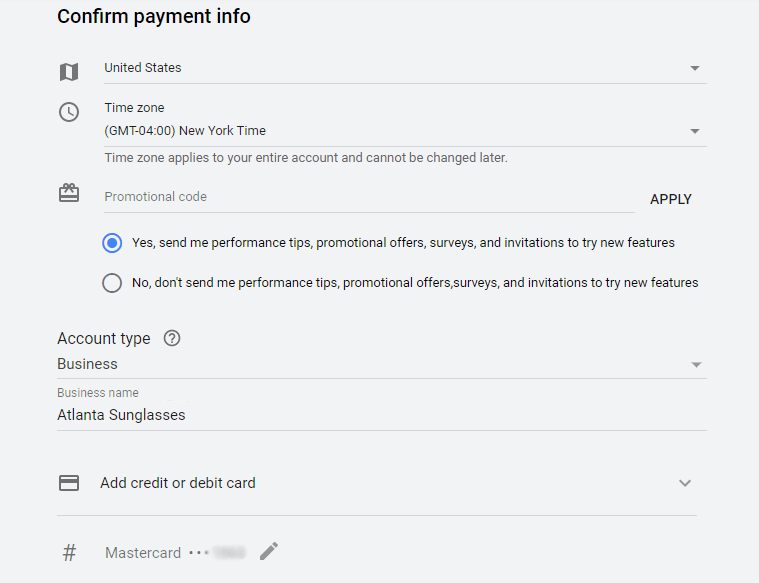
There, you should enter your card number and cardholder name if you choose the credit/debit card option. If you choose ‘Bank’, then you should enter the bank’s name, account type routing number, account number.
Then, click on Submit.
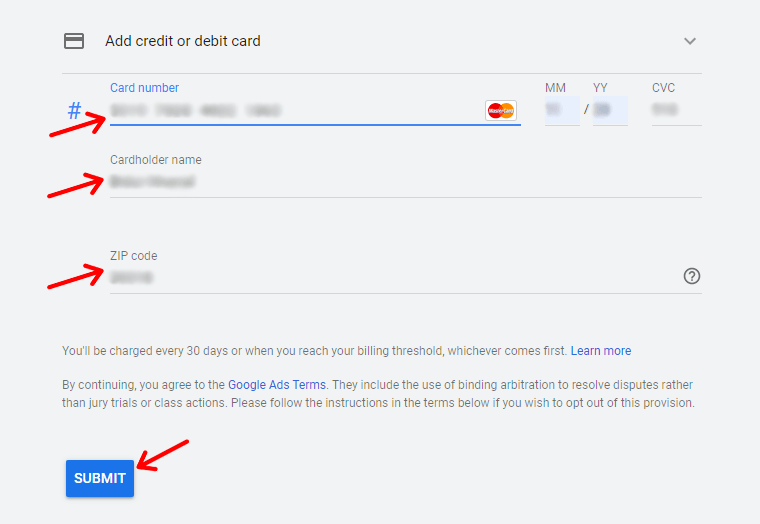
After completing all these steps, you’ll reach your Google Ads dashboard. From here, you can monitor your campaigns, edit keywords, settings, and view the analytics.

Step 7: Use Google Keyword Planner
Also, you’ll have access to the Google Keyword Planner tool. For that, go to Tools and Settings at the top. Then, go to Planning > Keyword Planner.
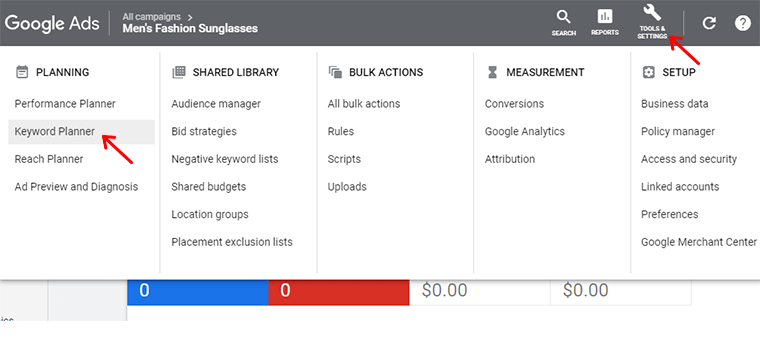
After that, click on ‘Discover new keywords’.
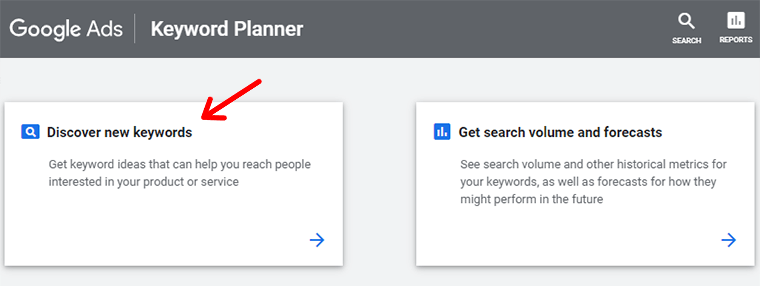
On the next page, enter one or more relevant keywords and click on ‘Get Results’.
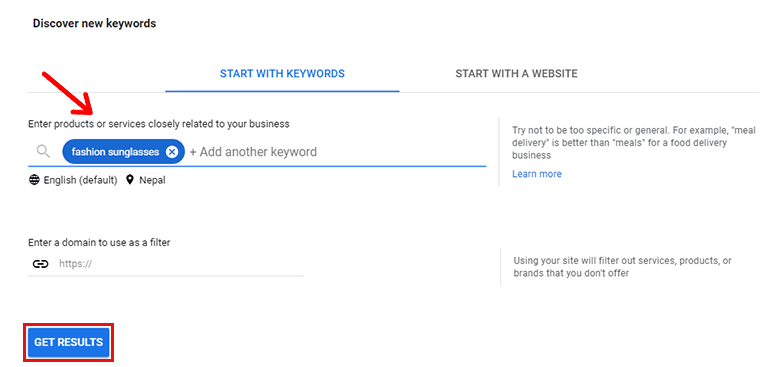
Then, it’ll display the keyword ideas related to your entered keywords with their monthly searches, competition, and CPCs. You can filter through them with your own thinking and add them to your ad group.
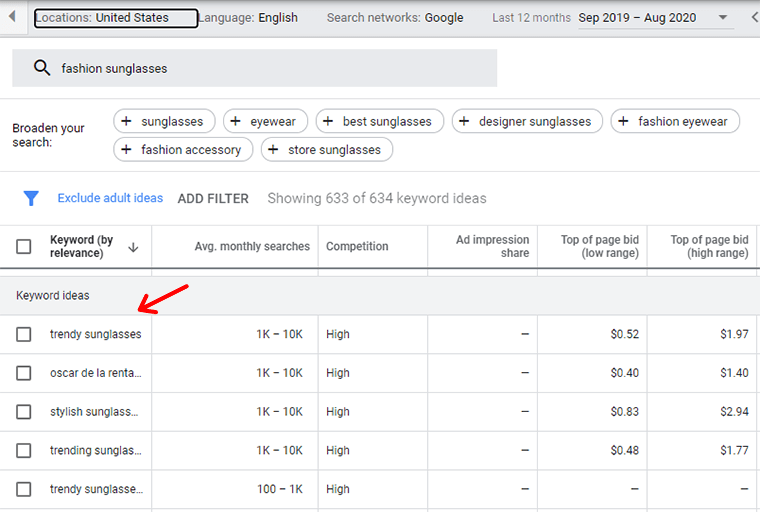
That’s it! It’s pretty simple.
But creating Google ads doesn’t guarantee success to you. You should make sure your ad content stands out. We’ll talk about such cool SEM strategies to adopt in the next section.
J. Cool SEM Strategies to Adopt
Let’s see some of the strategies you can apply in your search engine marketing campaign. These strategies help make your campaigns better for better returns.
- Good Keyword Research and Implementation – Proper keyword research is the key to search engine marketing. Follow the steps we’ve talked about earlier for keyword research. You can start by creating an initial list, then refine it for more obtaining specific keywords.
- Creating a Good Ad Copy – You need an attractive ad copy to drive more clicks on your ad. For that, write a more enticing header and description. Explain your services more precisely. Also, make sure to include keywords.
- Add Relevant Keywords in Ad Groups – While creating ad groups, make sure you add the most relevant keywords in one ad group. For keywords with different audience targets, you can create a different ad group. Also, pay more attention while setting match types.
- Target Customers on more SEM Platforms – Google accounts for about 85% to 90% of searches every month. So, advertising on Google gives your business good exposure. But besides this, you can also advertise on search engines like Bing, Yahoo, AOL, etc. as they have another set of audience who may be interested in your business.
- Relevant Landing Page – Your ad should direct your customers to a relevant and well-designed landing page. Meaning, the users should land on the right page where they will find what they’re looking for. If not, they can skip your site and buy from your competitors.
- Focus on SEO also – SEM and SEO are complementary to each other. Though they are 2 different ways of marketing online, they both are means of driving traffic through search engines. And, your SEM efforts with SEO tactics could help you yield more and long-term benefits.
- Analysis – After starting your paid campaign, you should also constantly study and check it. It gives you insights into how well your ad is performing. Analyze its rank, CTR (Click-Through Rate), conversion, etc., and keep improving.
With these strategies implemented, we believe that you do search engine marketing successfully and bring big results.
Conclusion
That’s it. We hope that this guide helped you know what is Search Engine Marketing (SEM) and every aspect related to it. We also hope that you understand how to carry out a paid campaign to improve your business with the best SEM strategies.
If you have any questions about search engine marketing, then please comment below. We’ll get back to you as soon as possible.
We also recommend you check the detailed guide on Search Engine Optimization (SEO). It helps you extend your business even more with the steady flow of organic traffic on your site.
Want to learn other types of online marketing and how to do it? Then, please check our ultimate digital marketing guide.
